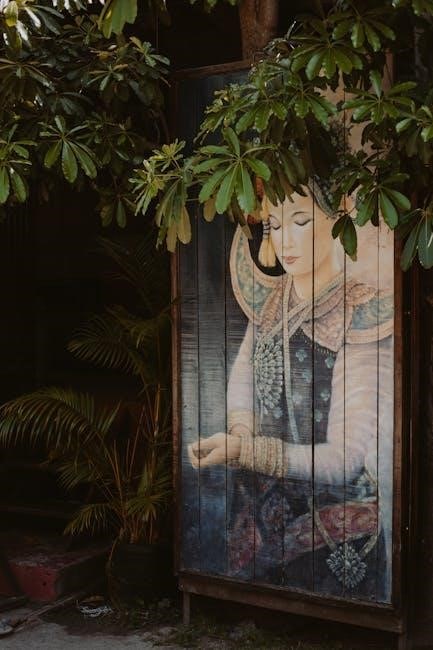The Mustard Seed Garden Manual of Painting, published in 1679, is a foundational guide to Chinese painting, offering systematic instruction on brushwork, composition, and technique while embodying Taoist principles and harmony with nature.
Overview of the Manual
The Mustard Seed Garden Manual of Painting, compiled in 1679, is a comprehensive guide to Chinese painting techniques, emphasizing brushwork, ink usage, and composition. It systematically teaches the fundamentals of landscape painting, including depictions of trees, rocks, and human figures. The manual is divided into volumes, each focusing on specific elements, and includes detailed illustrations to aid learning. Its structured approach makes it accessible to both beginners and advanced artists. The work is deeply rooted in Taoist philosophy, stressing harmony with nature and the expressive use of lines. It remains a cornerstone of Chinese art education, inspiring generations of artists like Qi Baishi and fostering a connection to traditional techniques and ideals.
Historical Significance
The Mustard Seed Garden Manual of Painting holds profound historical significance as a cornerstone of Chinese artistic education and tradition. First published in 1679, it marked a pivotal moment in the codification of painting techniques, influencing generations of artists. Its systematic approach and detailed illustrations set a new standard for instructional art manuals. The manual’s use of color printing was innovative for its time and showcased the evolution of artistic techniques in the Qing Dynasty. It has endured for centuries, shaping the development of Chinese painting and remaining a vital resource for both traditional and contemporary artists, ensuring the preservation of classical methods and philosophies.
The Mustard Seed Garden Manual of Painting was created as a comprehensive guide for artists, particularly beginners, to master Chinese painting techniques. Its purpose was to provide a systematic and accessible approach to learning the fundamentals of brushwork, composition, and ink usage. Intended for aspiring painters, the manual served as a foundational text, offering clear instructions and examples to help students develop their skills. It also aimed to preserve and transmit the philosophical underpinnings of Chinese art, such as Taoist principles and harmony with nature. Over time, it became an essential resource for both amateur and professional artists, ensuring the continuation of traditional painting methods while inspiring creativity and refinement.
Historical Background
The Mustard Seed Garden Manual of Painting emerged during the Qing dynasty, commissioned by Shen Xinyou and first published in 1679. It preserves traditional Chinese painting techniques and philosophies, influencing later artists and remaining a cornerstone of Chinese art education and practice.
Publication and Compilation
The Mustard Seed Garden Manual of Painting was first published in 1679 during the Qing dynasty. Commissioned by Shen Xinyou, the son-in-law of playwright Li Yu, it was compiled by Wang Gai, a prominent Nanjing artist, with contributions from other skilled painters. The manual was initially printed using advanced color woodblock techniques, showcasing intricate illustrations and detailed instructions. The first edition included three volumes, focusing on landscape elements like trees, rocks, and figures, while later editions expanded to include additional subjects. This systematic approach to teaching painting laid the groundwork for its enduring influence, making it a cornerstone of Chinese art education for centuries.
Key Contributors and Editors
The Mustard Seed Garden Manual of Painting was primarily compiled by Wang Gai (), a skilled landscape painter active during the late 17th to early 18th century. The project was initiated by Shen Xinyou, the son-in-law of the renowned playwright Li Yu, who sponsored the work. Wang Gai’s designs were influenced by earlier masters like Li Liufang (), a prominent Ming dynasty artist. Other contributors included Zhu Xi An and Wang Yun An, who specialized in flower and bamboo paintings. The manual’s third volume was edited by Wang Gai and his brothers, Wang Shi () and Wang Nie (), ensuring a cohesive and comprehensive guide to Chinese painting techniques.
Historical Context of Chinese Painting
The Mustard Seed Garden Manual of Painting emerged during the early Qing Dynasty, a period marked by both cultural continuity and innovation in Chinese art. It reflects the transition from the Ming to Qing dynasties, blending traditional techniques with evolving artistic sensibilities. The manual encapsulates the spirit of Chinese painting, emphasizing harmony with nature and the expression of Taoist philosophical ideals. Its systematic approach to teaching painting aligns with the broader cultural emphasis on education and mastery of classical forms. The manual also highlights the advancements in printing technology of the time, showcasing intricate woodblock prints that preserved the art form for future generations. It remains a cornerstone of Chinese artistic heritage, bridging historical traditions with modern practice.
Structure of the Manual
The Mustard Seed Garden Manual of Painting is organized into four volumes, covering principles of painting, trees, rocks, and human figures, with systematic guidance and detailed examples.
Volume Breakdown
The Mustard Seed Garden Manual of Painting is divided into four volumes, each focusing on specific aspects of Chinese painting. The first volume introduces fundamental principles, including brushwork and composition. The second volume delves into the depiction of trees, while the third explores rocks and landscapes. The fourth volume covers human figures and architectural elements. Later editions, published in 1701 and 1709, expanded the scope, incorporating sections on flowers, birds, and other natural subjects. This structured approach ensures a comprehensive learning experience, making the manual a seminal resource for artists and scholars alike.
Core Subjects Covered
The Mustard Seed Garden Manual of Painting covers essential elements of Chinese painting, including brushstroke techniques, color and ink usage, and composition. It focuses on natural subjects such as trees, rocks, and water, providing detailed guidance on capturing their forms and textures. The manual also includes sections on human figures, architecture, and floral motifs, offering step-by-step instructions for rendering these elements. Additionally, it explores the depiction of birds and animals, emphasizing harmony and balance in composition. The text is supplemented with illustrations, making it a comprehensive guide for mastering traditional Chinese painting techniques and styles.
Organization and Flow
The Mustard Seed Garden Manual of Painting is meticulously organized into volumes, each focusing on specific aspects of Chinese painting. The first volume introduces fundamental principles, while subsequent volumes delve into detailed techniques for depicting trees, rocks, water, and human figures. The manual progresses logically, starting with basic brushstrokes and advancing to complex compositions. Each section is supported by illustrations, reinforcing the instructions and providing visual guidance. This structured approach ensures learners can build skills progressively, mastering one element before moving to the next. Over time, the manual has been expanded and refined, maintaining its relevance as a cornerstone of Chinese art education.

Painting Techniques Explored
The manual systematically presents essential techniques like brushwork, ink gradation, and composition, emphasizing expressive lines and harmony in capturing natural forms and spiritual essence in art.
Brushstroke Techniques
The Mustard Seed Garden Manual of Painting dedicates significant attention to brushstroke techniques, emphasizing their expressive potential and role in capturing the essence of natural forms. It provides detailed guidance on various strokes, from delicate lines for leaves to bold movements for tree trunks and rocks. The manual underscores the importance of controlling ink flow and pressure to achieve dynamic textures and tones; By practicing these techniques, artists can master the fundamentals of Chinese painting, including rhythm, harmony, and the conveyance of vitality. These methods remain foundational for both traditional and contemporary artists, offering timeless insights into the art of brushwork.
Color and Ink Usage
The Mustard Seed Garden Manual of Painting extensively covers the use of color and ink, emphasizing their roles in creating harmony and balance. It highlights the importance of natural pigments, derived from minerals and plants, to achieve vibrant yet subtle hues. The manual demonstrates how ink can be layered to produce rich tonal variations, from deep blacks to delicate washes. Color is used sparingly but effectively to enhance compositions, while ink remains the backbone of expression. This approach reflects the Taoist principle of simplicity and the pursuit of natural beauty, guiding artists to master the interplay of color and ink for expressive and timeless results.
Composition and Layout
The Mustard Seed Garden Manual of Painting provides detailed guidance on composition and layout, emphasizing balance, harmony, and the dynamic arrangement of elements. It teaches artists to use negative space effectively, creating a sense of emptiness that draws the viewer’s eye. The manual illustrates how to structure landscapes by layering mountains, trees, and water, ensuring a logical flow. It also stresses the importance of hierarchy, guiding the viewer through the painting; Practical examples demonstrate how to arrange figures, houses, and natural elements cohesively. These principles, rooted in traditional Chinese aesthetics, help artists achieve visually pleasing and meaningful compositions that reflect the harmony of nature. The manual remains a cornerstone for mastering these essential techniques.

Influence on Chinese Art
The Mustard Seed Garden Manual of Painting profoundly influenced Chinese art, shaping techniques and inspiring generations of artists, including Qi Baishi, and remains a cornerstone of artistic education and practice.
Impact on Later Artists
The Mustard Seed Garden Manual of Painting had a profound impact on later artists, serving as a foundational guide for mastering traditional techniques. Renowned artists such as Qi Baishi credited the manual for shaping their early artistic skills, emphasizing its systematic approach to Chinese painting. Its detailed instructions and emphasis on harmony with nature inspired generations, making it a cornerstone of artistic education. The manual’s influence extended beyond traditional practices, bridging the gap between classical and modern art. Its timeless principles continue to guide contemporary artists, ensuring its relevance in evolving artistic landscapes. This enduring impact underscores its significance as a pivotal work in Chinese art history.
Role in Art Education
The Mustard Seed Garden Manual of Painting has played a pivotal role in art education, serving as a primary textbook for teaching traditional Chinese painting techniques. Its systematic approach and detailed instructions on brushwork, composition, and natural depictions have made it an essential resource for both novice and advanced artists. Many renowned painters, including Qi Baishi, began their artistic journeys with this manual. Its clear methodology and emphasis on foundational skills have ensured its continued use in art schools and by individual learners. The manual’s influence extends globally, with translations making it accessible to international students of Chinese art, solidifying its place as a cornerstone of artistic education.
Evolution of Techniques
The Mustard Seed Garden Manual of Painting has witnessed an evolution in techniques, adapting to artistic advancements while preserving traditional methods. Originally published in 1679, it introduced systematic brushwork and composition, influencing generations of artists. Over time, its techniques were refined, incorporating new materials and styles. Modern artists have integrated Western elements while maintaining the manual’s core principles, demonstrating its adaptability. The manual’s emphasis on expressive lines and harmony with nature remains central, ensuring its relevance in contemporary artistic practices. Its enduring influence highlights the balance between tradition and innovation, making it a timeless resource for artists worldwide.

Key Artists Associated with the Manual
Wang Gai, a prominent Qing Dynasty artist, compiled the manual, while renowned artists like Qi Baishi and others later drew inspiration from its timeless techniques and principles.
Wang Gai and His Contributions
Wang Gai, a prominent Qing Dynasty artist, was the primary compiler of the Mustard Seed Garden Manual of Painting. Active during the late 17th and early 18th centuries, he was commissioned by Shen Xinyou, son-in-law of the intellectual Li Yu, to create this comprehensive guide. Wang Gai’s work laid the foundation for the manual, which systematically covered essential painting techniques, including brushwork, ink usage, and composition. His contributions included detailed illustrations and instructions on drawing landscapes, trees, rocks, and figures, influenced by earlier masters like Li Liufang. The manual’s first volume, focusing on principles, was published in 1679, with subsequent volumes added later. Wang Gai’s efforts ensured the manual’s enduring influence, blending technical instruction with Taoist philosophical ideals of harmony and nature.
Other Notable Artists
Beyond Wang Gai, several other artists contributed to the Mustard Seed Garden Manual of Painting, enriching its content and legacy. Li Liufang, a Ming Dynasty artist, influenced Wang Gai’s work, while Zhu Xi An and Wang Yun An contributed floral paintings. Their collective efforts showcased diverse artistic styles. The manual also featured works by other Qing Dynasty artists, reflecting collaborative creativity. Notably, Qi Baishi, a modern master, credited the manual with shaping his early artistic understanding. Such contributions highlight the manual’s role as both an educational tool and a testament to the evolution of Chinese art, bridging generations of artists and inspiring global appreciation through its translations and widespread use.
Modern Artists Inspired by the Manual
The Mustard Seed Garden Manual continues to inspire modern artists, blending traditional techniques with contemporary interpretations. Qi Baishi, a renowned 20th-century artist, often credited the manual for shaping his early artistic vision. Similarly, Feng Mian, who studied in Paris, began his artistic journey with the manual, demonstrating its global influence. Modern artists like Xu Beihong and Pan Tianshou have also drawn inspiration from its systematic approach, integrating its principles into their work. These artists exemplify how the manual’s timeless wisdom continues to foster creativity, connecting past traditions with modern artistic expression and ensuring its relevance in today’s diverse art world.

Cultural and Philosophical Underpinnings
The Mustard Seed Garden Manual reflects Taoist principles, emphasizing harmony with nature and the balance of yin and yang. It uses symbolism to convey deeper spiritual truths.
Taoist Philosophy in Painting
The Mustard Seed Garden Manual of Painting deeply integrates Taoist philosophy, emphasizing harmony with nature and the balance of yin and yang. It encourages artists to embrace spontaneity and naturalness, reflecting the Taoist concept of “wu wei” or effortless action. The manual highlights the importance of capturing the spirit of subjects rather than just their forms, aligning with Taoist ideals of essence over appearance. Brushwork and composition are guided by principles of simplicity, fluidity, and the interconnectedness of all things. This philosophical underpinning inspires artists to connect with the natural world and convey profound meaning through their art.
Symbolism in Art
The Mustard Seed Garden Manual of Painting incorporates rich symbolism, reflecting the deeper meanings embedded in Chinese art. Symbols like bamboo, pine, and plum blossoms represent resilience, longevity, and purity, while orchids and chrysanthemums signify refinement and nobility. These symbols are often used to convey moral and philosophical ideals, encouraging artists to infuse their work with layers of meaning. The manual guides painters in using natural elements to express harmony and balance, aligning with Taoist and Confucian values. Through these symbols, the manual teaches artists to capture not just the form but the essence of their subjects, creating art that transcends mere representation. This approach remains influential in modern artistic practices.
Harmony with Nature
The Mustard Seed Garden Manual of Painting emphasizes harmony with nature, a core principle of Chinese art. It teaches artists to observe and depict the natural world with balance and sensitivity, capturing the essence of landscapes, trees, and flowers. The manual encourages painters to align their work with the rhythms of nature, reflecting seasonal changes and the organic forms of plants and rocks. By focusing on natural motifs and the subtle interplay of light and shadow, the manual guides artists in creating compositions that embody the tranquility and order of the natural world. This approach fosters a deep connection between the artist and their surroundings, promoting spiritual and creative harmony. The techniques outlined in the manual continue to inspire artists today.

Modern Relevance and Applications
The Mustard Seed Garden Manual of Painting remains a vital resource in contemporary art education, inspiring modern artists and offering timeless techniques for global practitioners.
Contemporary Use in Art Education
The Mustard Seed Garden Manual of Painting is widely used in modern art education, serving as a primary resource for understanding traditional Chinese painting techniques and principles. Its systematic approach to teaching brushwork, composition, and color continues to inspire both students and professional artists. Many art schools integrate the manual into their curricula, emphasizing its relevance in preserving and passing on classical methods. Additionally, its translations into multiple languages have made it accessible to a global audience, ensuring its influence extends beyond China to international art education programs. This timeless guide remains indispensable for anyone seeking to master traditional Chinese painting.
Translations and Global Reach
The Mustard Seed Garden Manual of Painting has been translated into multiple languages, including English, making it accessible to a global audience. The first English translation, titled The Tao of Painting, was published in 1956 by Mai-mai Sze. This translation introduced the manual’s principles and techniques to Western artists and scholars. Today, the manual is shared in various languages through digital platforms, further expanding its influence. Its global reach has inspired artists worldwide, blending traditional Chinese painting methods with contemporary practices. This timeless guide continues to bridge cultural gaps, fostering cross-cultural artistic exchange and appreciation for classical Chinese art.
Influence on Mixed Media
The Mustard Seed Garden Manual of Painting has inspired mixed media artists by blending traditional techniques with modern materials. Its emphasis on expressive brushwork and composition has influenced digital artists, who adapt these methods using software. The manual’s principles of harmony and balance are applied in collage and multimedia projects. Additionally, its systematic approach to art education has been integrated into interdisciplinary workshops, encouraging experimentation across mediums. This fusion of classic and contemporary practices highlights the manual’s enduring relevance, as it continues to inspire innovation in mixed media art, bridging the gap between traditional Chinese painting and modern creative expressions.
The Mustard Seed Garden Manual of Painting stands as a timeless classic, shaping Chinese art with its systematic approach and philosophical depth, ensuring its enduring relevance in modern artistic education and practice.
Legacy of the Manual
The Mustard Seed Garden Manual of Painting holds a revered place in Chinese art history, serving as a cornerstone for artistic education and practice for centuries. Its systematic approach to teaching painting techniques, combined with its incorporation of Taoist philosophy, has made it a foundational text for generations of artists. The manual’s influence extends beyond China, with translations and adaptations introducing its principles to global audiences. Its legacy is evident in the work of renowned artists like Qi Baishi, who credited it as a key inspiration. Today, the manual remains a vital resource, preserving traditional techniques while inspiring contemporary artists to explore its timeless wisdom.
Future Prospects
The Mustard Seed Garden Manual of Painting continues to be a vital resource for artists and educators worldwide. Its timeless techniques and philosophical insights ensure its relevance in modern art education. Digital platforms and translations are expanding its accessibility, introducing it to new audiences. As interest in traditional Chinese art grows, the manual serves as a bridge between ancient practices and contemporary creativity. It inspires innovative applications in mixed media and cross-cultural collaborations, ensuring its enduring influence. The manual’s future lies in its ability to adapt while preserving its core principles, making it a lasting legacy in the evolution of Chinese and global art.
